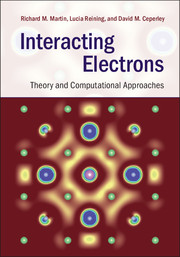Book contents
- Frontmatter
- Dedication
- Contents
- Preface
- Acknowledgments
- Notation
- Part I Interacting electrons: beyond the independent-particle picture
- Part II Foundations of theory for many-body systems
- Part III Many-body Green's function methods
- 9 Many-body perturbation theory: expansion in the interaction
- 10 Many-body perturbation theory via functional derivatives
- 11 The RPA and the GW approximation for the self-energy
- 12 GWA calculations in practice
- 13 GWA calculations: illustrative results
- 14 RPA and beyond: the Bethe–Salpeter equation
- 15 Beyond the GW approximation
- 16 Dynamical mean-field theory
- 17 Beyond the single-site approximation in DMFT
- 18 Solvers for embedded systems
- 19 Characteristic hamiltonians for solids with d and f states
- 20 Examples of calculations for solids with d and f states
- 21 Combining Green's functions approaches: an outlook
- Part IV Stochastic methods
- Part V Appendices
- References
- Index
17 - Beyond the single-site approximation in DMFT
from Part III - Many-body Green's function methods
Published online by Cambridge University Press: 05 June 2016
- Frontmatter
- Dedication
- Contents
- Preface
- Acknowledgments
- Notation
- Part I Interacting electrons: beyond the independent-particle picture
- Part II Foundations of theory for many-body systems
- Part III Many-body Green's function methods
- 9 Many-body perturbation theory: expansion in the interaction
- 10 Many-body perturbation theory via functional derivatives
- 11 The RPA and the GW approximation for the self-energy
- 12 GWA calculations in practice
- 13 GWA calculations: illustrative results
- 14 RPA and beyond: the Bethe–Salpeter equation
- 15 Beyond the GW approximation
- 16 Dynamical mean-field theory
- 17 Beyond the single-site approximation in DMFT
- 18 Solvers for embedded systems
- 19 Characteristic hamiltonians for solids with d and f states
- 20 Examples of calculations for solids with d and f states
- 21 Combining Green's functions approaches: an outlook
- Part IV Stochastic methods
- Part V Appendices
- References
- Index
Summary
Summary
The previous chapter is devoted to the formulation of DMFT and applications that are exact in the limit of infinite dimensions; however, in finite dimensions this is only a single-site approximation. The present chapter is devoted to clusters and other methods to treat correlation between sites. The equations are derived in a unified way, applicable to a single site or a cluster. For a cluster with more than one site there are various ways to choose the boundary conditions and the embedding procedure, and special care must be taken to satisfy causality and translation invariance. A few selected applications illustrate different techniques and results for Hubbard-type models.
The essential features of DMFT are brought out in the previous chapter in the simplest form: the single-site approximation in which correlation between sites can be neglected. In this case the self-energy due to interactions can be calculated using an auxiliary system of a single site embedded in an effective medium that represents the surrounding crystal. The resulting many-body problem is equivalent to an Anderson impurity model that must be solved self-consistently. The results are exact for infinite dimensions d → ∞; however, in any finite dimension, i.e., real systems, this is just a mean-field approximation analogous to the Weiss mean field in magnetic systems or the CPA for disordered alloys.
There are, however, many important properties and phenomena that require us to go beyond mean-field approximations. For example, basic questions concerning the nature of a metal–insulator transition can be established only by quantitative assessment of the correlations between different sites. Is a single site sufficient (the central idea in the arguments by Mott discussed in Sec. 3.2) or is correlation between sites (for example, an ordered antiferromagnetic state) essential for interactions to lead to an insulating state? A complete theory must establish the range of correlation needed to understand the mechanisms and to make quantitative calculations. A striking example that requires a k-dependent self-energy is the opening of a “pseudogap” in only part of the Brillouin zone in a high-temperature superconductor, as illustrated in Fig. 2.16.
This chapter is devoted to methods that go beyond the single-site approximation to take into account interactions and correlations between electrons on sites.
- Type
- Chapter
- Information
- Interacting ElectronsTheory and Computational Approaches, pp. 457 - 478Publisher: Cambridge University PressPrint publication year: 2016

